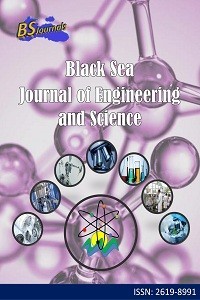Investigation of Defects Occurring in the Casting Shop Process of Ceramic Sanitaryware on the Final Product
When the export values of ceramic sanitaryware in Türkiye are analyzed, it is seen that the data for the year 2022 of ~660 million dollars continues to increase. In the sector, which reaches an annual average increase of 100 million dollars, the amount of production as well as the design demands change and shape the market. The most important difficulty factors in design are due to the fact that the products in the sector have large sizes, complex shapes and the most human-made production stages. When these factors are compared with other ceramic sectors, it is revealed that although industrialization has increased in the production of ceramic sanitaryware, the lack of production amount and the excess of faults are among the biggest problems. Glaze faults are the leading faults observed in the final product, and since this problem is not recyclable, it harms the ceramic sanitaryware industry in terms of cost. In this study, the glaze faults reflected in the final glazed products originating from the casting shop stage, which attracts attention in this field due to its large size and whiteness and there is not much data for the vitreous ware industry in the literature, have been studied. In the study, which was carried out with the aim of detecting and eliminating some faults in industrial production and creating data for the literature, faults arising from mechanical evenings used in classical and pressure casting benches and material residues used in retouching processes were determined. These faults were produced on the basis of the laboratory and the characterization of the glazed faulty products was made. It is concluded that production losses can be reduced by eliminating these problems, consequently increasing quality and productivity.
Investigation of Defects Occurring in the Casting Shop Process of Ceramic Sanitaryware on the Final Product
When the export values of ceramic sanitaryware in Türkiye are analyzed, it is seen that the data for the year 2022 of ~660 million dollars continues to increase. In the sector, which reaches an annual average increase of 100 million dollars, the amount of production as well as the design demands change and shape the market. The most important difficulty factors in design are due to the fact that the products in the sector have large sizes, complex shapes and the most human-made production stages. When these factors are compared with other ceramic sectors, it is revealed that although industrialization has increased in the production of ceramic sanitaryware, the lack of production amount and the excess of faults are among the biggest problems. Glaze faults are the leading faults observed in the final product, and since this problem is not recyclable, it harms the ceramic sanitaryware industry in terms of cost. In this study, the glaze faults reflected in the final glazed products originating from the casting shop stage, which attracts attention in this field due to its large size and whiteness and there is not much data for the vitreous ware industry in the literature, have been studied. In the study, which was carried out with the aim of detecting and eliminating some faults in industrial production and creating data for the literature, faults arising from mechanical evenings used in classical and pressure casting benches and material residues used in retouching processes were determined. These faults were produced on the basis of the laboratory and the characterization of the glazed faulty products was made. It is concluded that production losses can be reduced by eliminating these problems, consequently increasing quality and productivity.
___
- Berberoğlu FE. 2015. Seramik form ve yüzeylerde organik doku araştırmaları. Yüksek Lisans Tezi, Hacettepe Üniversitesi, Güzel Sanatlar Enstitüsü, Seramik Anasanat Dalı, İstanbul, Türkiye, ss: 61.
- Canduran K, Ural M. 2019. Seramik sağlık gereçleri üretiminde deformasyon oluşumunu önlemek için kullanılan aparatlar. Akademik Sanat, 4(8): 66–79.
- Daday MT. 2012. Seramik sağlık gereçlerinde damar hatalarının giderilmesi. Doktora Tezi, Anadolu Üniversitesi, Fen Bilimleri Enstitüsü, Seramik Mühendisliği Anabilim Dalı, Eskişehir, ss: 28-31.
- Fortuna A, Fortuna DM. 2017. An industrial approach to ceramics: sanitaryware. Plinius, 2017: 43.
- Fraser H. 2005. Ceramic faults and their remedies. A & C Black Publishers Ltd, New York, USA, pp: 138.
- Genç S, Öztürk RE, Göksel MM. 2018. Obrava pişirim tekniğinin bisküvi renkli ve sırlı bünyeler üzerinde etkileri. Anadolu Üniv Sanat Tasarım Derg, 2018:156–169.
- Genç S. 2010. Kapadokya güray müze - Kapadokya yeraltı seramik müzesi. URL: https://www.guraymuze.com/icerik/156/soner-genc/ (accessed date: August 20, 2023).
- Hasanuzzaman M, Islam F, Rashid ARMH. 2022. Investigation of methods to prevent pin-holing defect in tableware ceramic industry. Inter J Ceramic Engin Sci, 4(6): 416–425. https://doi.org/10.1002/CES2.10164
- Hopper R. 2023. 5 Glaze defects and expert solutions for fixing them. URL:
https://ceramicartsnetwork.org/daily/article/How-to- Correct-Five-Common-Ceramic-Glaze-Defects (accessed date: August 20, 2023).
- Kurama S, Sarı H. 2013. Seramik sağlık gereçleri bünyelerinde camsı faz kompozisyonunun pişirim sıcaklıklarına etkisi. Gazi Üniv Müh Mim Fak Der, 28(3) 445–454.
- Mete Z. 2020. Seramik kimyası. Tibyan Yayıncılık, İzmir, Türkiye, ss: 365.
- Taşkın Z. 2009. Krakle ve toplanmalı sırlar üzerine bir araştırma. Yüksek Lisans Tezi, Dokuz Eylül Üniversitesi, Güzel Sanatlar Enstitüsü, Seramik Anasanat Dalı, İzmir, Türkiye, ss: 108.
